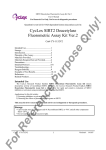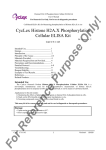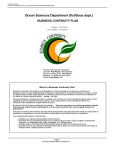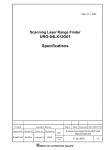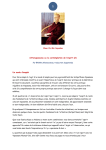Download For Reference Purpose Only!
Transcript
On ly! SIRT2 Deacetylase Fluorometric Assay Kit User’s Manual For Research Use Only, Not for use in diagnostic procedures Quantitative test kit for NAD-dependent histone deacetylase activity CycLex SIRT2 Deacetylase Fluorometric Assay Kit 100 Assays Pu Intended Use................................................1 Storage.........................................................1 Introduction..................................................2 Principle of the Assay..................................3 Materials Provided.......................................4 Materials Required but not Provided...........4 Precautions...................................................5 Detailed Protocol.........................................6-9 Cautions.......................................................10 Troubleshooting...........................................10 Reagent Stability..........................................10 Example of Test Results...............................11-13 References....................................................14 Related Products...........................................15 rp os e Cat# CY-1152 Intended Use ce The CycLex Research Product CycLex SIRT2 Deacetylase Fluorometric Assay Kit detects deacetylase activity of recombinant SIRT2. Primarily, the CycLex Research Product CycLex SIRT2 Deacetylase Fluorometric Assay Kit is designed for the rapid and sensitive evaluation of SIRT2 inhibitors or activators using recombinant SIRT2 or purified SIRT2. en Applications for this kit include: 1) Screening inhibitors or activators of SIRT2. 2) Detecting the effects of pharmacological agents on SIRT2. Storage er This assay kit is for research use only and not for use in diagnostic or therapeutic procedures. rR ef • Upon receipt store recombinant SIRT2 at -70°C and all other components below -20°C. • Don’t expose reagents to excessive light. Fo Cat#: CY-1152 1 Version#: 130130 On ly! SIRT2 Deacetylase Fluorometric Assay Kit User’s Manual For Research Use Only, Not for use in diagnostic procedures Introduction rR ef er en ce Pu rp os e Sir2 is a conserved protein and was recently shown to regulate lifespan extension both in budding yeast and nematode. In 2000, it was reported that the yeast Sir2 protein is a NAD(+)-dependent histone deacetylase that plays a critical role in transcriptional silencing, genome stability and longevity. In mammals, the homologs of Sir2 have been named sirtuins (SIRT), with seven members in a family termed SIRT1 through SIRT7. They share a conserved central deacetylase domain but have different Nand C termini and display distinct subcellular localization, suggesting different biological functions (1). In contrast to SIRT1, mammalian SIRT2 is localized mainly in the cytoplasm. SIRT2 colocalizes with the microtubule network and deacetylates Lys40 of alpha-tubulin (2). The same residue of alpha-tubulin is also deacetylated by HDAC6, a class II HDAC, and deacetylation by HDAC6 leads to changes in cellular motility (3). A role for SIRT2 in cancer pathogenesis was demonstrated using a proteomic approach (4). The SIRT2 gene, which is located at chromosome 19q13.2, lies within a region that is frequently deleted in human gliomas, and levels of SIRT2 mRNA and protein expression are severely reduced in a large fraction of human glioma cell lines (4). Ectopic expression of SIRT2 in these cell lines suppressed colony formation and modified the microtubule network. These results indicate that SIRT2 may act as a tumor suppressor and may function to control the cell cycle by acetylation of alpha-tubulin. It was reported that SIRT2 inhibitor rescued alpha-synuclein toxicity and modified inclusion morphology in a cellular model of Parkinson’s disease, however the exact mechanism remains uncertain. However, the conventional method for measuring SIRT2 activity is very complicated and laborious. In order to measure SIRT2 enzyme activity, it is necessary to prepare radioactive acetylated histone H4 as a substrate. First, cells have to be labeled metabolically with radioactivity by adding radioactive acetic acid to the culture medium. Second, radioactive acetylated histone has to be purified from the cells. Following the reaction, it is necessary to extract and separate the radioactive acetyl group, which has been released from acetylated histone, using ethyl acetate to measure the activity of the enzyme based on the radioactivity. Although a method for measuring the activity of deacetylase without the use of radioactive substances was reported in recent years, owing to the use of fluorescent-labeled acetylated lysine as a substrate, the reaction product must be separated from the intact substrate and the fluorescent intensity measured by reverse phase HPLC. As mentioned above, these measurement systems are difficult to adapt for processing many samples under a variety of conditions, because of their complicated operation. Thus a simple system for biochemical analysis as well as for inhibitor screening without the use of radioactive substances is preferred. Fo Cat#: CY-1152 2 Version#: 130130 On ly! SIRT2 Deacetylase Fluorometric Assay Kit User’s Manual For Research Use Only, Not for use in diagnostic procedures Principle of the Assay rp os e CycLex SIRT2 Deacetylase Fluorometric Assay Kit measures the activity of SIRT2 by the basic principle of changing a SIRT2 reaction into the activity of the protease. In order to measure the enzyme activity of SIRT2, which is the NAD dependent histone deacetylase, this kit is designed so that the activity of NAD dependent histone deacetylase can be measured under existence of Trichostatin A, which is the powerful inhibitor of HDACs. In this kit, fluorophore and quencher are coupled to amino terminal and carboxyl terminal of substrate peptide, respectively, and before reaction of deacetylase, the fluorescence cannot be emitted. However, if SIRT2 performs deacetylation, substrate peptide will become cut by the action of protease added simultaneously, quencher will separate from fluorophore, and fluorescence will be emitted. Deacetylase enzyme activity is measured by measuring this fluorescence intensity. Since it is very simple to measure and it can be performed at a low price, the measurement of SIRT2 activity in most laboratories is possible if they are equipped with a fluorescent reader for microtiter plates. Considering that the use of fully automatic apparatus to measure fluorescence intensity has become widespread, SIRT2 activity measurement, which could not be made by the conventional method, is now possible with the CycLex SIRT2 Deacetylase Fluorometric Assay Kit using the same equipment. This new method of measurement should dramatically raise the efficiency of inhibitor screening and biochemical analysis of these enzymes. Pu Measuring Principle of The CycLex SIRT2 Deacetylase Fluorometric Assay Kit fluorophore - X-X-X-Lys(Ac) -X-X-X-quencher Deacetylase ce fluorophore - X-X-X-Lys -X-X-X-quencher fluorophore - X-X-X-Lys Lysylendopeptidase + X-X X-quencher en Measurement of fluorescence intensity rR ef er Note: This measuring principle and kit are covered under CycLex’s patents. U.S. Patent No. 7,033,778 and No. 7256013 European Patent No. 1243658 Japanese Patent No. 4267043 Canadian Patent No. 2392711 Fo Cat#: CY-1152 3 Version#: 130130 Materials Provided Each kit contains ① ② ③ ④ ⑤ ⑥ ⑦ ⑧ ⑨ 10X SIRT2 assay buffer 50X Fluoro-Substrate Peptide (1 mM) 50X Fluoro-Deacetylated Peptide Lysylendopeptidase (100 mAU/ml) 100X NAD (80 mM) 200X Trichostatin A (0.2 mM) Recombinant SIRT2 100X Stop solution Instruction manual Materials Required but not Provided Quantity 1 ml x 2 100 µl lx 1 lx 1 50 µl 50 µl lx 1 100 µl lx 1 lx 1 100 µl 200 µl lx 1 100 µl lx 1 1 Storage Below -20°C Below -20°C Below -20°C Below -20°C Below -20°C Below -20°C -70°C Below -20°C rp os e Materials On ly! SIRT2 Deacetylase Fluorometric Assay Kit User’s Manual For Research Use Only, Not for use in diagnostic procedures room temp. rR ef er en ce Pu • Microplate for fluorometer • Microplate reading fluorometer capable of excitation at a wavelength in the range 490±10 nm and detection of emitted light in the range 530±10 nm. • Pipettors: 2-20 µL, 20-200 µL and 200-1000 µL precision pipettors with disposable tips. • Multi-channel pipette • Microplate shaker • Deionized water of the highest quality • 500 or 1000 mL graduated cylinder • Reagent reservoirs Fo Cat#: CY-1152 4 Version#: 130130 On ly! SIRT2 Deacetylase Fluorometric Assay Kit User’s Manual For Research Use Only, Not for use in diagnostic procedures Precautions • Please thaw ②50X Fluoro-Substrate Peptide and ③50X Fluoro-Deacetylated Peptide at room temperature before use. Then, thaw the other reagents in ice and use after they are completely thawed. • Please avoid repeated freezing and thawing of the recombinant SIRT2 in this kit. There is a possibility that the enzyme activity may be inactivated. Aliquot to 10-20 µL and store at –70°C rp os e • Please avoid mixing of protease inhibitors such as PMSF, or alkyl amine in the sample that will be measured SIRT2 activity. • Do not use kit components beyond the indicated kit expiration date. • Rinse all detergent residue from glassware. • Use deionized water of the highest quality. • Do not mix reagents from different kits. • Do not mouth pipet or ingest any of the reagents. Pu • Do not smoke, eat, or drink when performing the assay or in areas where samples or reagents are handled. rR ef er en ce • Biological samples may be contaminated with infectious agents. Do not ingest, expose to open wounds or breathe aerosols. Wear protective gloves and dispose of biological samples properly. Fo Cat#: CY-1152 5 Version#: 130130 On ly! SIRT2 Deacetylase Fluorometric Assay Kit User’s Manual For Research Use Only, Not for use in diagnostic procedures Detailed Protocol Description of assay system rp os e CycLex SIRT2 Deacetylase Fluorometric Assay Kit can measure the enzyme activity of SIRT2 with a homogeneous method. In this method, the reaction is initiated and the fluorescence intensity is measured by mixing simultaneously fluorescence-labeled acetylated peptide, which is substrate, SIRT2, trichostatin A, NAD and lysylendopeptidase. Since the reaction is not stopped, it is necessary to measure fluorescence intensity at regular intervals after the reaction is initiated, and to determine reaction velocity. Alternatively, within a time in which the reaction velocity is kept constant, it is also possible to stop the reaction by adding 2X stop solution and to measure fluorescence intensity. Preparation Method for Assay Reagents Thaw ②50X Fluoro-Substrate Peptide and ③50X Fluoro-Deacetylated Peptide at room temperature. Stand other reagents in ice to thaw. Use them after they thaw completely. Pu #1. 1X SIRT2 assay buffer (50 mM Tris-HCl (pH 8.8), 0.5 mM DTT) Quantity Required: 50 µL/assay ・Dilute the ①10X SIRT2 assay buffer 1:10 with distilled water. Since this is the base buffer for the assay, prepare 1 vial (1 ml) of ①10X SIRT2 assay buffer mixed with 9 ml of dH2O and store SIRT2 assay buffer at 4°C. #2. X20 diluted Lysylendopeptidase (5 mAU/ml) Quantity required: 2.5 µL/assay ・Dilute the ④Lysylendopeptidase 1:20 with #1. 1X SIRT2 assay buffer. ce #3. 10X NAD (8 mM β-NAD) Quantity required: 5 µL/assay ・Dilute the ⑤100X NAD 1:10 with #1. 1X SIRT2 assay buffer. en #4. 10X TSA (10 µM) Quantity required: 5 µL/assay ・Dilute the ⑥200X Trichostatin A 1:20 with #1. 1X SIRT2 assay buffer. er #5. 10X Test sample (10X final concentration, e.g. a candidate of inhibitor or activator) Quantity Required: 5 µL/assay ・Dilute Test sample to 10X final desired concentration with #1. 1X SIRT2 assay buffer. ef #6. X5 diluted recombinant SIRT2 Quantity Required: 10 µL/assay ・Dilute the ⑦recombinant SIRT2 1:5 with #1. 1X SIRT2 assay buffer. (Note! Use “#6. X5 diluted recombinant SIRT2” within the same day they are prepared.) rR #7. 2X Stop solution Quantity required: 50 µL/assay ・Dilute the ⑧100X Stop solution 1:50 with dH2O. Fo Cat#: CY-1152 6 Version#: 130130 On ly! SIRT2 Deacetylase Fluorometric Assay Kit User’s Manual For Research Use Only, Not for use in diagnostic procedures #8. SIRT2 reaction buffer (Final 50 mM Tris-HCl (pH 8.8), 0.5 mM DTT, 0.25 mAU/ml Lysylendopeptidase, 1 µM Trichostatin A and 20 µM Fluoro-Substrate Peptide in 50 µL of reaction mixture) Quantity Required: 30 µL/assay (in case of adding 10 µL of “#6. X5 diluted recombinant SIRT2” and 5 µL of “#5. 10X Test sample”) ・Mix following reagents (30 µL/1 assay) 5 µL 1 µL 2.5 µL 5 µL 16.5 µL 30 µL rp os e ①10X SIRT2 assay buffer ②50X Fluoro-Substrate Peptide #2. X20 diluted Lysylendopeptidase #4. 10X TSA dH2O Total rR ef er en ce Pu 1. 2. 3. 4. 5. Fo Cat#: CY-1152 7 Version#: 130130 On ly! SIRT2 Deacetylase Fluorometric Assay Kit User’s Manual For Research Use Only, Not for use in diagnostic procedures SIRT2 Assay Procedures 1. Assay method No enzyme control #8. SIRT2 reaction buffer #3. 10X NAD #5. 10X Test sample dH2O 30 µL 5 µL 5 µL - 30 µL 5 µL 15 µL No Test sample control 30 µL 5 µL 5 µL #6. X5 diluted recombinant SIRT2 (or Your enzyme sample) 10 µL - 10 µL No NAD control rp os e Test sample Assay reagents 30 µL 10 µL 10 µL 1) Following the above table, add Reagent #3, #5 and #8 or dH2O to each well of the microplate. Finally, initiate reaction by adding 10 µL of “#6. X5 diluted recombinant SIRT2” or “your enzyme sample” to each well and mixing thoroughly. Incubate at room temperature (Ca.25°C). Pu 2) Read fluorescence intensity for 60 to 120 minutes at 5 to 10 minute intervals using microtiter plate fluorometer with excitation at 490±10 nm and emission at 530±10 nm. Measure and calculate the rate of reaction while the reaction velocity remains constant. Alternate procedure 1’) Following the above table, add Reagent #3, #5 and #8 or dH2O to each well of the microplate. Finally, initiate reaction by adding 10 µL of “#6. X5 diluted recombinant SIRT2” or “your enzyme” to each well and mixing thoroughly. Incubate at room temperature (Ca.25°C). ce 2’) While the reaction rate is kept constant, add 50 µL of “#7. 2X Stop solution “ to each well at appropriate time to stop the reaction, and measure fluorescence intensity in a microplate fluorescence reader with excitation at 490±10 nm and emission at 530±10 nm en 3’) The difference in fluorescence intensity between “No Test sample control” and “No enzyme control” indicates the SIRT2 activity. er Note-1: It is possible to change the volume of assay reagents and sample as far as it sets up the final concentration of each reagents in a reaction mixture as indicated as below. rR ef Note-2: Duplicate measurement is strongly recommended. Fo Cat#: CY-1152 8 Version#: 130130 On ly! SIRT2 Deacetylase Fluorometric Assay Kit User’s Manual For Research Use Only, Not for use in diagnostic procedures 2. Assay control rp os e 1. When the chemicals that have an inhibitory effect on lysylendopeptidase come to be mixed in SIRT2 fraction purified from various cells or the immunoprecipitate using the specific antibody against SIRT2 or other proteins, precise SIRT2 enzyme activity cannot be measured. Since the protease inhibitors used in the usual protein purification process strongly inhibit lysylendopeptidase activity, please avoid using any protease inhibitors during the process of protein purification. If there is such a possibility, please carry out the experiment of “Positive control” and “Assay control-1” in the following table, using Fluoro-Deacetylated Peptide to reference. When Fluoro-Deacetylated Peptide is used, fluorescence intensity should increase whenever there is no SIRT2 activity in your enzyme sample. When there is an inhibitory effect on lysylendopeptidase activity, even if there is SIRT2 activity in a sample, fluorescence intensity should not increase. 2. Not only when an inhibitory effect on SIRT2 is in test chemicals, but also when there is an inhibitory effect on lysylendopeptidase, final fluorescence intensity will not increase. Please use Fluoro-Deacetylated Peptide instead of Fluoro-Substrate Peptide, and please carry out the experiment of “Positive control” and “Assay control-2” that does not add SIRT2 in the following Table. Although fluorescence intensity increases when Fluoro-Deacetylated Peptide is used, when an inhibitory effect on lysylendopeptidase activity occurs in a test chemicals, fluorescence intensity does not increase. Assay control-1 Assay control-2 Positive control ① 10X SIRT2 assay buffer ③ 50X Fluoro-Deacetylated Peptide #3. 10X NAD #4. 10X TSA #5. 10X Test sample #6. X5 diluted recombinant SIRT2 (or Your enzyme sample) dH2O 5 µL 1 µL 5 µL 5 µL 5 µL 5 µL 1 µL 5 µL 5 µL 5 µL - 5 µL 1 µL 5 µL 5 µL - 26.5 µL 26.5 µL 31.5 µL 2.5 µL 2.5 µL 2.5 µL ce Pu Assay reagents #2. X20 diluted Lysylendopeptidase en 1) Following the table above, add Reagent ①, ③, #3, #4, #5 or #6 and dH2O to each well. Finally, add 2.5 µL of “#2. X20 diluted Lysylendopeptidase” to each well and mix thoroughly to initiate reaction. 2) Incubate for 60 min or desired length of time at room temperature (Ca.25°C). er 3) Add 50 µL of “#7. 2X Stop solution” to each well. rR ef 4) Read fluorescence intensity using microtiter plate fluorometer with excitation at 490±10 nm and emission at 530±10 nm. Fo Cat#: CY-1152 9 Version#: 130130 On ly! SIRT2 Deacetylase Fluorometric Assay Kit User’s Manual For Research Use Only, Not for use in diagnostic procedures Cautions 1. In order to measure the activity of SIRT2 correctly, it is necessary to conduct the control experiments for “No enzyme control” and “No NAD control” at least once in addition to “No Test sample control,” as indicated in the above table of Assay method. Although fluorescence intensity increases in “No Test sample control” when SIRT2 enzyme activity is in the sample, the increase in fluorescence intensity is not observed in “No enzyme control” and “No NAD control”. rp os e 2. In order to estimate the inhibitory effect on SIRT2 activity in the Test sample correctly, it is necessary to conduct the control experiment of “No Test sample control” at least once for every experiment and “No NAD control” at least once for the first experiment, in addition to “Test sample” as indicated in the above table of Assay method. When test chemicals cause an inhibitory effect on SIRT2 activity, the level of increase of fluorescence intensity is weakened as compared with “No Test sample control”. The increase in fluorescence intensity is not observed in “No NAD control”. For research use only, not for use in diagnostic or therapeutic procedures Troubleshooting Pu 1. When chemicals that have an inhibitory effect on lysylendopeptidase are mixed in a crude SIRT2 fraction purified from various cells or the immunoprecipitate using a specific antibody against SIRT2 or other proteins, precise SIRT2 enzyme activity cannot be measured. Since the protease inhibitors used in the usual protein purification process inhibit lysylendopeptidase activity strongly, please avoid the use of any protease inhibitors during the protein purification process. 2. Final fluorescence intensity will not increase, both when test chemicals have an inhibitory effect on SIRT2, and also when there is an inhibitory effect on lysylendopeptidase. ce 3. If the test reagents themselves emit fluorescence at excitation wavelength: 480-500 nm and fluorescence wavelength: 520-540 nm, the inhibitory effect of the test assay cannot be evaluated correctly. en 4. The recombinant SIRT2 should be run in duplicate, using the protocol described in the Detailed Protocol. Incubation times or temperatures significantly different from those specified may give erroneous results. er 5. The reaction curve is nearly a straight line if the kinetics of the assay is of the first order. Variations in the protocol can lead to non-linearity of the curve, as can assay kinetics that are other than first order. For a non-linear curve, point to point or quadratic curve fit methods should be used. 6. Poor duplicates indicate inaccurate dispensing. If all instructions in the Detailed Protocol were followed accurately, such results indicate a need for multi-channel pipettor maintenance. ef Reagent Stability rR All of the reagents included in the CycLex Research Product CycLex SIRT2 Assay kit have been tested for stability. Reagents should not be used beyond the stated expiration date. Upon receipt, store the ⑦Recombinant SIRT2 at -70°C, all other kit reagents should be stored below -20°C. Fo Cat#: CY-1152 10 Version#: 130130 On ly! SIRT2 Deacetylase Fluorometric Assay Kit User’s Manual For Research Use Only, Not for use in diagnostic procedures Example of Test Results Fig.1 Dose dependency curve of recombinant SIRT2 activity 6,000 rp os e F485/F535 x10 -2 5,000 4,000 3,000 2,000 1,000 0 0.5 1.0 1.5 SIRT2 (ug) Pu 0.0 2.0 2.5 Fig.2 Time course of SIRT2-substrate deacetylation by recombinant SIRT2 14,000 ce 2.0 ug 1.0 ug 12,000 0.5 ug 0.25 ug en 8,000 6,000 4,000 er F485/F535 x10 -2 10,000 rR ef 2,000 Fo Cat#: CY-1152 0 0 20 40 60 80 100 120 Reaction time (min) 11 Version#: 130130 On ly! SIRT2 Deacetylase Fluorometric Assay Kit User’s Manual For Research Use Only, Not for use in diagnostic procedures Fig.3 Efect of Trichostatin A and NAD on recombinant SIRT2 activity 2,500 1,500 1,000 500 0 TSA (+) NAD (-) NAD (+) Pu TSA (-) rp os e F485/F535 x10 -2 2,000 Fig.4 Effect of Sirtinol on recombinant SITR2 activity ce 6,000 5,000 3,000 er 2,000 en F485/F535 x10 -2 4,000 1,000 rR ef 0 Fo Cat#: CY-1152 0 15.6 62.5 250 1000 No enzyme No NAD Sirtinol conc. (uM) 12 Version#: 130130 On ly! SIRT2 Deacetylase Fluorometric Assay Kit User’s Manual For Research Use Only, Not for use in diagnostic procedures Fig.5 Effect of Resveratrol on recombinant SITR2 activity 6,000 -2 5,000 F485/F535 x10 4,000 rp os e 3,000 2,000 1,000 0 0 15.6 62.5 250 1000 rR ef er en ce Pu Reveratrol conc. (uM) No No enzyme NAD Fo Cat#: CY-1152 13 Version#: 130130 On ly! SIRT2 Deacetylase Fluorometric Assay Kit User’s Manual For Research Use Only, Not for use in diagnostic procedures References 1. North, B.J., and Verdin, E.; Sirtuins: SIRT2-related NAD-dependent protein deacetylases. Genome Biol. 5: 224, 2004 2. North BJ, Marshall BL, Borra MT, Denu JM, Verdin E; The human SIRT2 ortholog, SIRT2, is an NAD+-dependent tubulin deacetylase. Mol Cell 11:437-444, 2003 rp os e 3. Hubbert C, Guardiola A, Shao R, Kawaguchi Y, Ito A, Nixon A, Yoshida M, Wang XF, Yao TP; HDAC6 is a microtubule-associated deacetylase. Nature 417: 455-458, 2002 4. Hiratsuka M, Inoue T, Toda T, Kimura N, Shirayoshi Y, Kamitani H, Watanabe T, Ohama E, Tahimic CG, Kurimasa A, Oshimura M; Proteomics-based identification of differentially expressed genes in human gliomas: down-regulation of SIRT2 gene. BBRC 309: 558-566, 2003 5. S Imai, CM Armstrong, M Kaeberlein, and L Guarente; Transcriptional silencing and longevity protein Sir2 is an NAD-dependent histone deacetylase. Nature. 403: 795-800, 2000 6. Joseph Landry, Ann Sutton, Stefan T. Tafrov, Ryan C. Heller, John Stebbins, Lorraine Pillus, and Rolf Sternglanz; The silencing protein SIR2 and its homologs are NAD-dependent protein deacetylases Proc Natl Acad Sci U S A 97: 5807-5811, 2000 Pu 7. Jeffrey S. Smith, Carrie Baker Brachmann, Ivana Celic, Margaret A. Kenna, Shabazz Muhammad, Vincent J. Starai, Jose L. Avalos, Jorge C. Escalante-Semerena, Charles Grubmeyer, Cynthia Wolberger, and Jef D. Boeke; A phylogenetically conserved NAD+-dependent protein deacetylase activity in the Sir2 protein family Proc Natl Acad Sci U S A 97, 6658-6663, 2000 ce 8. H Vaziri, SK Dessain, E Ng Eaton, SI Imai, RA Frye, TK Pandita, L Guarente, and RA Weinberg; hSIR2 (SIRT1) functions as an NAD-dependent p53 deacetylase. Cell. 107: 149-159, 2001 9. J Luo, AY Nikolaev, S Imai, D Chen, F Su, A Shiloh, L Guarente, and W Gu; Negative control of p53 by Sir2alpha promotes cell survival under stress. Cell. 107: 137-148, 2001 en 10. E Langley, M Pearson, M Faretta, UM Bauer, RA Frye, S Minucci, PG Pelicci, and T Kouzarides; Human SIR2 deacetylates p53 and antagonizes PML/p53-induced cellular senescence. EMBO J. 21: 2383-2396, 2002 11. J Smith; Human Sir2 and the 'silencing' of p53 activity. Trends Cell Biol. 12: 404, 2002 rR ef er 12. CM Grozinger and SL Schreiber; Deacetylase enzymes: biological functions and the use of small-molecule inhibitors. Chem Biol, 9: 3-16, 2002 Fo Cat#: CY-1152 14 Version#: 130130 On ly! SIRT2 Deacetylase Fluorometric Assay Kit User’s Manual For Research Use Only, Not for use in diagnostic procedures Related Products Pu rp os e * CycLex Cellular Histone Acetylation Assay Kit: Cat# CY-1140 * CycLex HDACs Deacetylase Fluorometric Assay Kit: Cat# CY-1150 * CycLex HDAC8 Deacetylase Fluorometric Assay Kit: Cat# CY-1158 * CycLex SIRT1/Sir2 Deacetylase Fluorometric Assay Kit: Cat# CY-1151 * CycLex SIRT2 Deacetylase Fluorometric Assay Kit: Cat# CY-1152 * CycLex SIRT3 Deacetylase Fluorometric Assay Kit: Cat# CY-1153 * CycLex SIRT6 Deacetylase Fluorometric Assay Kit: Cat# CY-1156 * Anti-Acetylated Histone/p53-K382 Mouse Monoclonal Antibody: Cat# CY-M1029 * Anti-Histone Deacetylase 1 (HDAC1) Rabbit Polyclonal Antibody: Cat# CY-P1011 * Anti-Histone Deacetylase 2 (HDAC2) Rabbit Polyclonal Antibody: Cat# CY-P1012 * Anti-Human SIRT1 Rabbit Polyclonal Antibody: Cat# CY-P1016 * NAD(+)-Dependent Deacetylase SIRT1: Cat# CY-E1151 * NAD(+)-Dependent Deacetylase SIRT2: Cat# CY-E1152 * NAD(+)-Dependent Deacetylase SIRT3: Cat# CY-E1153 * NAMPT (Nicotinamide Phosphoribosyltransferase): Cat# CY-E1251 * NMNAT1 (Nicotinamide Mononucleotide Adenylyltransferase 1): Cat# CY-E1252 PRODUCED BY en ce Note: This product is covered under CycLex’s patents. U.S. Patent No. 7,033,778 and No. 7256013 European Patent No. 1243658 Japanese Patent No. 4267043 Canadian Patent No. 2392711 ef er CycLex Co., Ltd. 1063-103 Terasawaoka Ina, Nagano 396-0002 Japan Fax: +81-265-76-7618 e-mail: [email protected] URL: http://www.cyclex.co.jp rR CycLex/CircuLex products are supplied for research use only. CycLex/CircuLex products and components thereof may not be resold, modified for resale, or used to manufacture commercial products without prior written approval from CycLex Co., Ltd.. To inquire about licensing for such commercial use, please contact us via email. Fo Cat#: CY-1152 15 Version#: 130130















